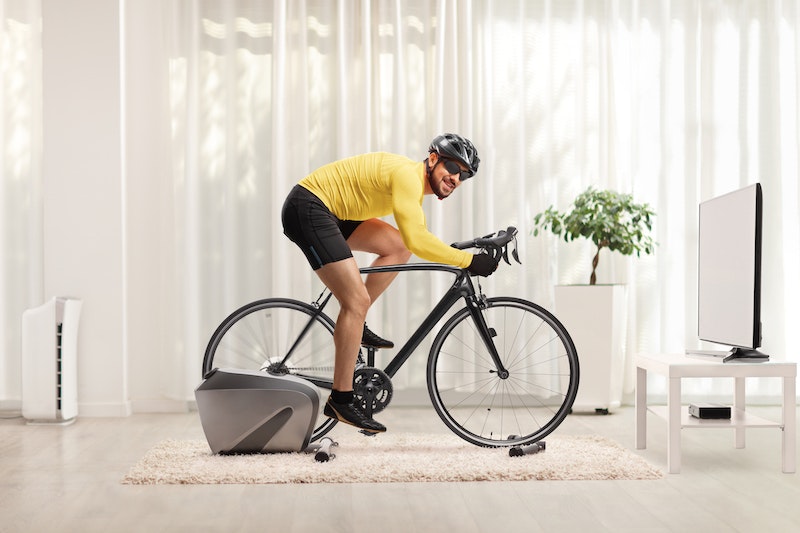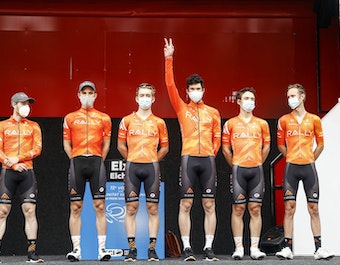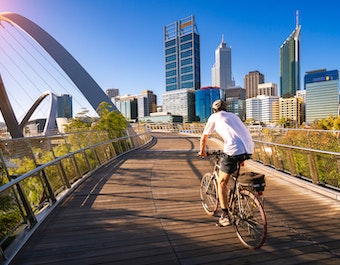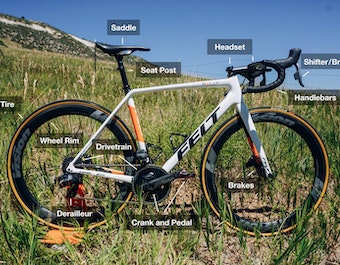Improve your airflow
“The biggest mistake people make riding inside is definitely not having appropriate airflow," says Rally cyclist Robin Carpenter. It’s important to find a cool place to ride because when you’re not moving forward, you have no airflow hitting you. Unless you can keep cool with fans, open windows or a chilly basement, you'll be sweat-soaked within minutes.
“I think the coldest place that you can find in your house is the best place to do your riding,” Carpenter says. “But even in a cold spot, you need a good fan. There's no way around it, because it’s miserable when you're overheating and sweat is dripping in your eyes. When I lived on the East Coast, I would just pull the trainer outside and ride on the porch. It was much better than finishing in a puddle of sweat inside.”
Commit to a training space
If you haven’t already, carve out a spot in your home where you can leave your bike set up, and make it your own. Canadian racer Matteo Dal-Cin grew up spending hours every week riding the trainer during Ottawa's intense winters. Having a home setup where the bike is ready, the fans are already set up and in place, and you have a spot to set your computer screen or TV up makes riding regularly a lot easier, he says.
“It makes a big difference if all you need to do is put your shorts and shoes on and you’re ready to go,” he says. If you can dedicate a corner of your basement or garage to biking, consider adding things like motivational photos or slogans, a yoga mat for pre- and post-ride stretching and core work, and even a water bottle fill station.
Invest in good bike shorts
Gym shorts or leggings might do in a pinch, but a pair of shorts that are designed for cycling have padding to protect you from the friction caused by your saddle and can make your ride much more pleasant. “Don't skimp on your cycling shorts: Get a good pair that has a comfortable chamois,” says Dal-Cin. “People spend too much time trying to hunt down the perfect saddle or perfect trainer or perfect bike fit without realizing that the vast majority of ride comfort comes from what you're wearing, not what you're sitting on.”
Focus on quality over quantity
None of the cyclists on the Rally team love training inside, but they all have to do it at least part of the year. To maximize efficiency on the trainer, they all focus on quality over quantity. That means doing highly specific interval sessions where they focus on speed and power rather than time on the saddle.
“I think the most important thing is that you're mentally prepared for what’s coming," says German racer Clara Koppenburg. “I don't love riding indoors, but it is really efficient training. You’re always working when you're riding indoors: There are no stop signs, you never coast on a downhill. You can be really focused on doing your intervals properly.”
“Try to keep it interesting: Don't just pedal,” says Carpenter. “It doesn't have to be fancy: You can even make up intervals as you go, going hard for a few seconds or a minute, then taking it easy, then going hard again. Just change it up and keep it interesting for yourself. There's no magic formula for doing the right kind of interval.”
And spread intervals throughout your ride, if possible. Often, cyclists will do a long warmup, a short specific set of intervals, and a long cool down. But Rally cyclist Pier-André Côté is a fan of instead spreading his harder efforts over his entire trainer ride. “I usually take a lot of rest in between my intervals, so that when I do efforts, they can be really hard, really close to my maximum capacity,” he says. “That helps make the whole ride seem shorter, since those extended rests and hard efforts add up quickly but you never get bored.”
Play with new tech
Indoor training has come a long way in recent years. Most people have heard of Peloton, but there are other apps available (for free or with subscription options) that simulate workouts that you’d get in a spin studio. There are also apps that turn your indoor bike into a virtual reality-style video game: Zwift and RGT are just two of the platforms that put you onto a virtual race course, and you can join in on group rides with cyclists riding inside all over the world.
“There's a lot of apps that can help keep it fun and interesting, and with a smart trainer that can sync to your app, you can actually have the resistance change with what's happening on the screen. It can make your ride inside feel a lot more like riding on the road,” says longtime team member Krista Doebel-Hickok.
Make a coffee date
“Riding with friends [virtually] is one of the main things that helps me ride better indoors,” says Côté, one of the newer members of the Rally Cycling team. Côté’s early cycling years in Quebec City involved a lot of indoor trainer time when snow piled up outside. Finding distraction is key. “I'll actually call friends who are also riding, and we'll FaceTime while we ride,” he says. “Sometimes for long rides, we even do 'coffee stops' where we all get off of our bikes and get a coffee in the kitchen, like how we would normally stop at a coffee shop on a ride.”
Remember your why
“When you're just riding without a purpose, it feels like time is going in slow motion,” Côté says. But if you have a purpose for your workout, it will feel much easier.
That might mean focusing on a health goal (say, improving your blood pressure numbers) or racking up a certain number of miles in a month. Or it might be as simple as mapping out a clear workout plan to break your ride into smaller goals.
“It makes it much easier if you can say, 'OK, today I have 10 minutes to warm up, then five sets of 2 minutes hard and 3 minutes easy, and then a 10 minute cooldown,'” Doebel-Hickok adds.
A ride indoors might never rival a scenic spin through the countryside or city streets. But with a little planning, it can be a fun, efficient way to stay in shape and meet your goals.






